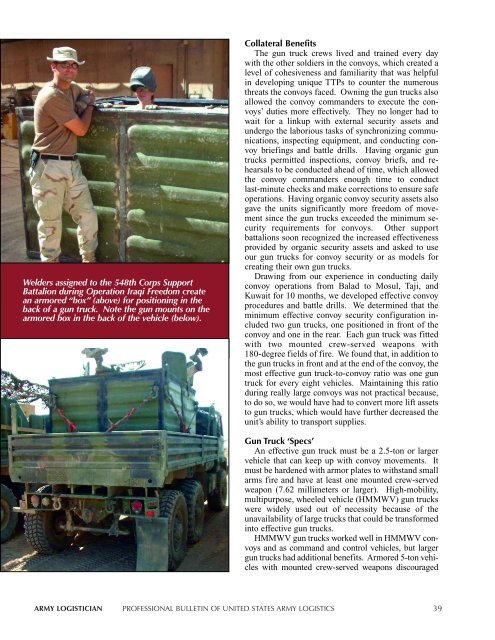Supporting the First Stryker Brigade in Iraq - Army Logistics ...
Supporting the First Stryker Brigade in Iraq - Army Logistics ...
Supporting the First Stryker Brigade in Iraq - Army Logistics ...
You also want an ePaper? Increase the reach of your titles
YUMPU automatically turns print PDFs into web optimized ePapers that Google loves.
Welders assigned to <strong>the</strong> 548th Corps Support<br />
Battalion dur<strong>in</strong>g Operation <strong>Iraq</strong>i Freedom create<br />
an armored “box” (above) for position<strong>in</strong>g <strong>in</strong> <strong>the</strong><br />
back of a gun truck. Note <strong>the</strong> gun mounts on <strong>the</strong><br />
armored box <strong>in</strong> <strong>the</strong> back of <strong>the</strong> vehicle (below).<br />
Collateral Benefits<br />
The gun truck crews lived and tra<strong>in</strong>ed every day<br />
with <strong>the</strong> o<strong>the</strong>r soldiers <strong>in</strong> <strong>the</strong> convoys, which created a<br />
level of cohesiveness and familiarity that was helpful<br />
<strong>in</strong> develop<strong>in</strong>g unique TTPs to counter <strong>the</strong> numerous<br />
threats <strong>the</strong> convoys faced. Own<strong>in</strong>g <strong>the</strong> gun trucks also<br />
allowed <strong>the</strong> convoy commanders to execute <strong>the</strong> convoys’<br />
duties more effectively. They no longer had to<br />
wait for a l<strong>in</strong>kup with external security assets and<br />
undergo <strong>the</strong> laborious tasks of synchroniz<strong>in</strong>g communications,<br />
<strong>in</strong>spect<strong>in</strong>g equipment, and conduct<strong>in</strong>g convoy<br />
brief<strong>in</strong>gs and battle drills. Hav<strong>in</strong>g organic gun<br />
trucks permitted <strong>in</strong>spections, convoy briefs, and rehearsals<br />
to be conducted ahead of time, which allowed<br />
<strong>the</strong> convoy commanders enough time to conduct<br />
last-m<strong>in</strong>ute checks and make corrections to ensure safe<br />
operations. Hav<strong>in</strong>g organic convoy security assets also<br />
gave <strong>the</strong> units significantly more freedom of movement<br />
s<strong>in</strong>ce <strong>the</strong> gun trucks exceeded <strong>the</strong> m<strong>in</strong>imum security<br />
requirements for convoys. O<strong>the</strong>r support<br />
battalions soon recognized <strong>the</strong> <strong>in</strong>creased effectiveness<br />
provided by organic security assets and asked to use<br />
our gun trucks for convoy security or as models for<br />
creat<strong>in</strong>g <strong>the</strong>ir own gun trucks.<br />
Draw<strong>in</strong>g from our experience <strong>in</strong> conduct<strong>in</strong>g daily<br />
convoy operations from Balad to Mosul, Taji, and<br />
Kuwait for 10 months, we developed effective convoy<br />
procedures and battle drills. We determ<strong>in</strong>ed that <strong>the</strong><br />
m<strong>in</strong>imum effective convoy security configuration <strong>in</strong>cluded<br />
two gun trucks, one positioned <strong>in</strong> front of <strong>the</strong><br />
convoy and one <strong>in</strong> <strong>the</strong> rear. Each gun truck was fitted<br />
with two mounted crew-served weapons with<br />
180-degree fields of fire. We found that, <strong>in</strong> addition to<br />
<strong>the</strong> gun trucks <strong>in</strong> front and at <strong>the</strong> end of <strong>the</strong> convoy, <strong>the</strong><br />
most effective gun truck-to-convoy ratio was one gun<br />
truck for every eight vehicles. Ma<strong>in</strong>ta<strong>in</strong><strong>in</strong>g this ratio<br />
dur<strong>in</strong>g really large convoys was not practical because,<br />
to do so, we would have had to convert more lift assets<br />
to gun trucks, which would have fur<strong>the</strong>r decreased <strong>the</strong><br />
unit’s ability to transport supplies.<br />
Gun Truck ‘Specs’<br />
An effective gun truck must be a 2.5-ton or larger<br />
vehicle that can keep up with convoy movements. It<br />
must be hardened with armor plates to withstand small<br />
arms fire and have at least one mounted crew-served<br />
weapon (7.62 millimeters or larger). High-mobility,<br />
multipurpose, wheeled vehicle (HMMWV) gun trucks<br />
were widely used out of necessity because of <strong>the</strong><br />
unavailability of large trucks that could be transformed<br />
<strong>in</strong>to effective gun trucks.<br />
HMMWV gun trucks worked well <strong>in</strong> HMMWV convoys<br />
and as command and control vehicles, but larger<br />
gun trucks had additional benefits. Armored 5-ton vehicles<br />
with mounted crew-served weapons discouraged<br />
ARMY LOGISTICIAN PROFESSIONAL BULLETIN OF UNITED STATES ARMY LOGISTICS 39







